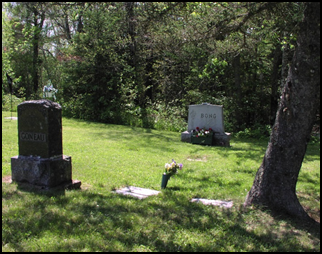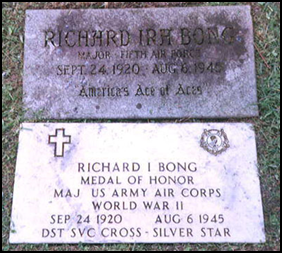Richard Ira Bong Tombstone
Poplar Cemetery
Poplar, Wisconsin
 |
 |
On September 27, 2007 while on vacation I drove from my waterfront hotel in Duluth, Minnesota eastward into neighboring Wisconsin. My destination was Poplar, a small hamlet 20 miles east of Duluth/Superior and location of a small rural cemetery containing the grave of Richard Ira Bong (1920-1945). Bong was a World War II aviator credited with shooting down 40 enemy aircraft, an all-time record in the annals of American military aviation.
Bong had enlisted just before Pearl Harbor and began flight training as an aviation cadet in California where he showed great promise flying the P-38, a two engine fighter then being developed and tested. He impressed all who saw him and even a dumb stunt flying under the center span of the Golden Gate Bridge and then down Market Street in San Francisco at little more than tree top level failed to hold him back. While many of his classmates were destined for Europe and aerial combat with the Luftwaffe, Bong with his mastery of the P-38 was chosen to be part of a new squadron forming for duty in the SW Pacific to contest Japanese air superiority.
It was shortly after his arrival in the Pacific Theatre that his squadron of 12 P-38’s intercepted and engaged a flight of 25 Japanese fighters and bombers in the skies over Dobodura in Papua. The fight was short and intense with 15 Japanese planes being destroyed without loss of a single P-38. Bong was credited with his first two kills.
For the next 18 months Bong flew numerous missions where he displayed his piloting skills, an uncanny eye for gunnery and perhaps an equal amount of luck in downing another 26 enemy aircraft. With his reputation soaring and his confirmed count at 28 it was decided to send Bong stateside for both R&R and some publicity value on the home front. His arrival back in Superior at the controls of a P-38 was highlighted by another stunt dive bombing at full open throttle a nearby Lake Superior shipyard then busy with war production. The arrival of his plane caused considerable panic and consternation among the shipyard workers on the ground until it was realized that it was their local hero coming home. All was immediately forgiven and Bong spent an enjoyable rest period amid the admirers and well-wishers of the town. With his leave over but before returning to combat Bong was sent to a new stateside six week gunnery course. The intent was to use him as a base trainer upon his return to the Pacific although keeping him on the ground proved almost impossible. Under orders to avoid risk and shoot only in self-defense Bong returned to the air and in the next six weeks accounted for an additional 8 Japanese aircraft destroyed.
Having won every air medal then available, his commanding general (George Kenney) recommended Bong for the Congressional Medal of Honor. Shortly approved back in Washington the medal was presented in person by Gen. Douglas MacArthur at Tacloban Air Base in the Philippines. Bong then returned to combat freelancing of sorts with the generals now fretting about what the possible loss of their best pilot so late in the war would do to morale. Bong, meanwhile, was still flying and accounted for 4 additional enemy planes lost. His count was now at 40 confirmed losses. Bong had flown 146 combat missions totaling over 400 hours, accounted for 40 confirmed enemy losses and is believed to have shot down perhaps another 40 but listed as probable and unconfirmed. Rotation home was often granted to pilots after 25 missions. Bong had done his job and was long overdue to be rotated home. While Bong expressed an interest in staying around long enough for 50 confirmed kills, General Kenney had seen enough. Orders were cut ordering Bong home for good with plans to use him as a test pilot for a new jet fighter then being developed by Lockheed.
Bong arrived in the states in early January 1945, a war hero whose picture appeared in countless newspapers and magazines. Upon his return to the states he first enjoyed an extended leave in Poplar where among other things he married his sweetheart. He was then ordered to report to Wright Field in Dayton to undergo classroom instruction to learn about the new jet fighter. Upon conclusion of the classwork Bong then reported to Burbank, California to the Lockheed plant where the P-80 jet fighter was under construction and where he would begin duty as a test pilot.
On August 6, 1945, the day a B-29 dropped the atomic bomb over Hiroshima, Bong took off on a test flight. Bong only had four hours flight time in the new jet. There were still developmental bugs being worked out in the plane’s design although no one deemed it unsafe to fly. However, another test pilot had been killed just a week earlier. Bong’s plane suffered a flameout on takeoff. Bong stayed with the aircraft attempting to steer it away from a nearby housing development. The stalled engine soon careened the jet back to earth where it turned over and exploded. Bong was killed instantly. Ironically after serving almost three years in a combat war zone without suffering as much as a scratch, Bong lost his life stateside on a test flight with the war basically over.
Two days later his body was returned to Superior aboard an Army transport plane escorted by 18 P-38 fighters. Military personnel (including generals), politicians and family and friends attended his funeral service in Superior. A funeral procession then wound its way across northern Wisconsin to his boyhood home of Poplar where he was buried with full military honors in a family plot. Today the grave sites are marked by a large tombstone with the surname Bong while the individual graves have smaller markers. Bong’s marker is a standard marble slab with pertinent detail but directly adjacent is a similarly sized granite slab that proclaims Bong to be “America’s Ace of Aces”. It’s a simple grave for a small town boy who became a national war hero, gave his life for his country and perfectly personified what TV news anchor Tom Brokaw called “America’s Finest Generation”.